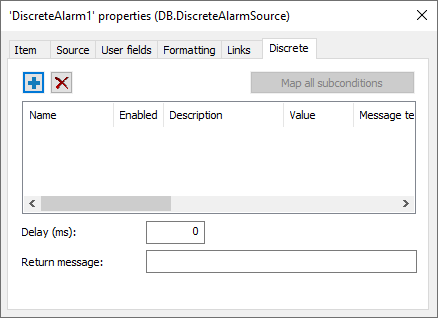Allows monitoring a variable by specifying multiple sub-conditions.

Discrete tab
The available options on this tab are described on the next table.
Available options for the Discrete tab
Option |
Description |
|---|---|
Add Subcondition |
Adds a new Sub-condition to this alarm |
Remove Subcondition |
Removes the selected Sub-condition |
Map all subconditions |
Allows mapping and syncing Alarm Sub-conditions from semantics available in the source object. This feature is currently supported only by Elipse Power server objects, therefore this option remains disabled by default in E3 |
Name |
Sub-condition's name |
Enabled |
Enables or disables this Sub-condition |
Description |
Sub-condition's description |
Value |
A value evaluated to determine whether this alarm occurs or not |
Message text |
Message displayed when this Sub-condition is active |
Type |
Sub-condition's behavior. Available options are 0: Alarm, 1: Event, or 2: Return |
Severity |
Sub-condition's severity type. Available options are -2: Critical, 0: High, 1: Medium, or 2: Low |
Need Ack? |
Indicates whether this Sub-condition needs acknowledgment or not |
Allow shelving? |
Enables or disables shelving this alarm's Sub-condition |
Shelve maximum duration |
Maximum time, in minutes, this alarm's Sub-condition can remain shelved. Default value of this option is 60 (one hour) |
Maximum shelve count |
Maximum number of times this alarm's Sub-condition can be shelved. Default value of this option is 0 (zero), that is, no limit |
Delay (ms) |
Specifies a delay time, in milliseconds. When this value is equal to 0 (zero, default), no delay is applied |
Return message |
Allows specifying a text displayed to users when this alarm is not in an active condition |